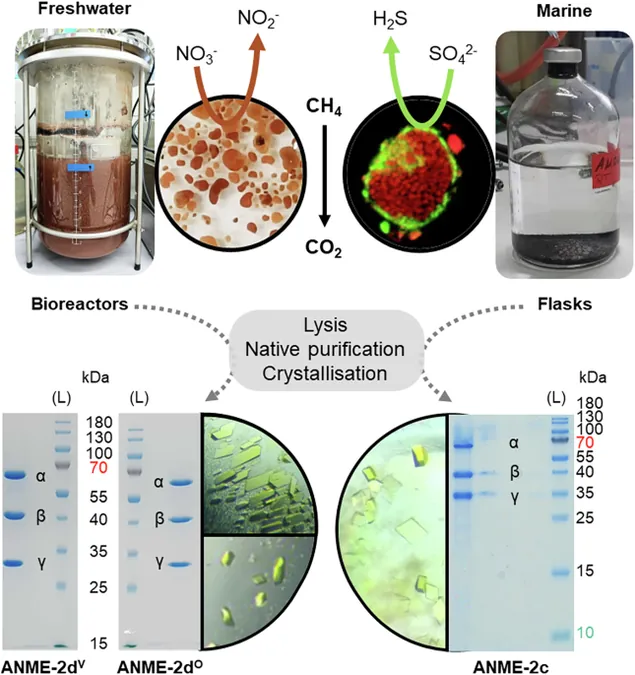
Unlocking the Secrets of Methane-Eating Microbes: New Insights from the ANME Enzyme
2025-09-05
Author: Jia
The Climate Crisis and Methane—A Hidden Player
As the world grapples with climate change, understanding methane emissions has never been more crucial. This potent greenhouse gas is significantly transformed into CO2 in ocean sediments through anaerobic oxidation, a process that can reduce methane emissions by up to 50% in aquatic ecosystems.
Meet the Methane Oxidizers: ANME Microbes Unveiled
Enter anaerobic methanotrophic archaea, or ANME, microorganisms capable of oxidizing methane without oxygen. Found predominantly in marine sediments, ANME thrive on methane, linking electron transfer to sulfate-reducing bacteria through unique communication structures known as nanowires. New studies reveal their surprising abilities extend to reducing nitrate and even generating electricity.
Diverse Yet Distinct: The ANME Family Challenge
Despite their shared methane-oxidizing capabilities, the ANME groups—particularly ANME-1 and ANME-2/ANME-3—are genetically diverse. Understanding these differences is essential for unlocking their molecular mechanisms. Researchers are racing against time as cultivating these microbes is notoriously challenging due to their slow growth rates.
The Enzyme on the Front Lines: Methyl-Coenzyme M Reductase (MCR) Takes Center Stage
At the heart of the anaerobic oxidation process lies the Methyl-Coenzyme M Reductase (MCR), pivotal for converting methane into a less harmful form. New research uncovers the intricate structure of MCR, revealing why it's considered the most abundant enzyme in ANME.
Unveiling Structural Mysteries: Post-Translational Modifications in MCR
MCR features a conserved architecture, but what truly sets it apart are post-translational modifications (PTMs) not seen in other methanogens. These modifications are scattered throughout the enzyme's structure yet remain largely unexplained. Significant new findings suggest that the ANME-specific adaptations help optimize its function in methane oxidation.
The Journey of Discovery: Success in Purification and Structural Analysis
Through meticulous purification efforts from microbial consortia dominated by ANME-2, researchers achieved remarkable breakthroughs in understanding how these enzymes work at an atomic level. Novel insights into MCR's unique PTMs and its active site architecture pave the way for future innovations in methane mitigation technology.
Fascinating Findings: The Role of PTMs and Evolutionary Insights
With ANME-2 MCRs boasting seven different PTMs, the complexity of these adaptations signals potential evolutionary advantages in methane activation, a biochemical process that’s crucial for reducing emissions. This diversity reflects the need for further comparative studies among various ANME groups.
Towards a Sustainable Future: Harnessing ANME Innovations
The implications of this research are immense. By understanding the mechanics of these methane-consuming microbes and their enzymes, we can design more effective biotechnological solutions for carbon capture, steering us closer to a zero-carbon future.
Conclusion: Unveiling the Mysteries Could Change Everything
The intricate world of ANME and their enzymes remains a goldmine for scientific exploration. As researchers dive deeper into the molecular labyrinth of these methane-oxidizing archaea, the findings not only enhance our environmental knowledge but also hold the key to groundbreaking green technologies.



 Brasil (PT)
Brasil (PT)
 Canada (EN)
Canada (EN)
 Chile (ES)
Chile (ES)
 Česko (CS)
Česko (CS)
 대한민국 (KO)
대한민국 (KO)
 España (ES)
España (ES)
 France (FR)
France (FR)
 Hong Kong (EN)
Hong Kong (EN)
 Italia (IT)
Italia (IT)
 日本 (JA)
日本 (JA)
 Magyarország (HU)
Magyarország (HU)
 Norge (NO)
Norge (NO)
 Polska (PL)
Polska (PL)
 Schweiz (DE)
Schweiz (DE)
 Singapore (EN)
Singapore (EN)
 Sverige (SV)
Sverige (SV)
 Suomi (FI)
Suomi (FI)
 Türkiye (TR)
Türkiye (TR)
 الإمارات العربية المتحدة (AR)
الإمارات العربية المتحدة (AR)